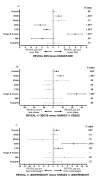Comparison of body habitus in patients with pulmonary arterial hypertension enrolled in the Registry to Evaluate Early and Long-term PAH Disease Management with normative values from the National Health and Nutrition Examination Survey
- PMID: 21282484
- PMCID: PMC3031434
- DOI: 10.4065/mcp.2010.0394
Comparison of body habitus in patients with pulmonary arterial hypertension enrolled in the Registry to Evaluate Early and Long-term PAH Disease Management with normative values from the National Health and Nutrition Examination Survey
Abstract
Objective: To investigate the correlation between body mass index (BMI) and pulmonary artery systolic pressure in a large population of patients with pulmonary arterial hypertension (PAH).
Patients and methods: The BMI of patients with group 1 PAH enrolled in the Registry to Evaluate Early and Long-term PAH Disease Management (REVEAL) was compared with that of age- and sex-matched controls in the National Health and Nutrition Examination Survey (NHANES) to clarify whether obesity is linked with PAH. The diagnosis of PAH was defined in REVEAL by right-sided heart catheterization. Differences in BMI and the percentage of patients considered obese (BMI ≥30) and underweight (BMI <18.5) in various subgroups of patients enrolled in REVEAL from March 30, 2006, through September 11, 2007, were determined.
Results: Mean BMI was no different for patients with PAH (n=2141) than for the NHANES normal comparison group; however, the proportion of obese and underweight patients was increased in patients with PAH. Subgroup analysis demonstrated that subgroups with idiopathic PAH and those with PAH associated with drugs and toxins had both higher BMI and percentage of obese patients, whereas 3 other subgroups (those with PAH associated with congenital heart disease, connective tissue disease, and human immunodeficiency virus) had lower mean BMI.
Conclusion: Mean BMI of the REVEAL patients was the same as that of the NHANES normal comparison group; however, there were higher percentages of obese and underweight patients in REVEAL. This discrepancy can be explained by the balancing effect of more overweight and underweight patients in different PAH subgroups. The reason for the increased frequency of obesity in idiopathic PAH is unknown, and additional study is needed.
Trial registration: ClinicalTrials.gov NCT00370214.
Figures

References
-
- Catenacci VA, Hill JO, Wyatt HR. The obesity epidemic. Clin Chest Med. 2009;30:415-444, vii - PubMed
-
- Ogden CL, Yanovski SZ, Carroll MD, Flegal KM. The epidemiology of obesity. Gastroenterology. 2007;132:2087-2102 - PubMed
-
- Badesch DB, Raskob GE, Elliott CG, et al. Pulmonary arterial hypertension: baseline characteristics from the REVEAL registry. Chest. 2010;137:376-387 - PubMed
-
- Taichman DB, Mandel J. Epidemiology of pulmonary arterial hypertension. Clin Chest Med. 2007;28:1-22, vii - PubMed
-
- McQuillan BM, Picard MH, Leavitt M, Weyman AE. Clinical correlates and reference intervals for pulmonary artery systolic pressure among echocardiographically normal subjects. Circulation. 2001;104:2797-2802 - PubMed

